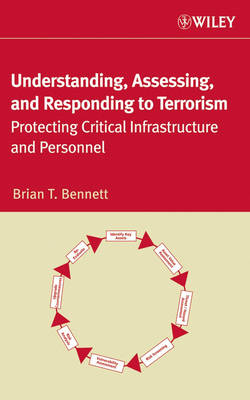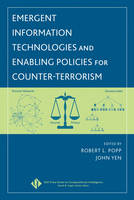Understanding, Assessing, and Responding to Terrorism
Understanding, Assessing, and Responding to Terrorism
Protecting Critical Infrastructure and Personnel
Bennett, Brian P.
John Wiley and Sons Ltd
04/2007
480
Dura
Inglês
9780471771524
882
Descrição não disponível.
Preface xiii 1. The Terrorist Threat 1 1.1 What Is Terrorism? 1 1.2 Terrorism Statistics 2 1.3 Purpose of Terrorism 2 1.4 Goals of Terrorism 3 1.5 Case Study: Economic Effects of a Terrorist Attack 4 1.6 Objectives of Terrorism 4 1.7 The Terrorism Challenge 5 1.8 What is Homeland Security? 5 1.9 The Motivation for Terrorism 20 1.10 Common Terms in Terrorism 20 1.11 Types of Terrorists 23 1.12 Historical Terrorist Attacks 26 1.13 International Terrorism 27 1.14 Examples of International Terrorist Groups 31 1.15 Terrorist Groups that Claimed Responsibility for Terrorist Attacks in 2004 36 1.16 Recent International Terrorist Attacks 38 1.17 Domestic Terrorism 44 1.18 Examples of Domestic Terrorist Groups 46 1.19 Recent Domestic Terrorist Attacks 48 References 50 2. Critical Infrastructure 51 2.1 Introduction 51 2.2 Evolution of the Definition of Critical Infrastructure 51 2.3 Current Definition of Critical Infrastructure 53 2.4 Definition of Key Resources 54 2.5 Definition of Key Assets 54 2.6 Discussion of Critical Infrastructure 54 2.7 Soft Targets 62 2.8 Hard Targets 62 2.9 Cascading Effects from Interdependencies of Critical Infrastructures 63 2.10 Coordination of Critical Infrastructure Protection 64 2.11 Selection of Critical Infrastructure and Key Assets 67 2.12 Identification and Selection of Soft Targets by a Jurisdiction 68 2.13 Inventorying and Prioritizing Critical Infrastructure/Key Resources/Key Assets/Soft Targets 69 References 83 Appendix 2.1 Executive Order 13010 by President William J. Clinton 84 Appendix 2.2 Presidential Decision Directive 63 by President William J. Clinton 88 Appendix 2.3 Executive Order 13228 by President George W. Bush 100 Appendix 2.4 Executive Order 13231 by President George W. Bush 106 Appendix 2.5 Homeland Security Presidential Directive 7 by President George W. Bush 115 3. Types of Terrorist Attacks 123 3.1 Introduction 123 3.2 Types of Destructive Events 124 3.3 Who Can Execute an Attack? 124 3.4 Ways in Which an Asset May be Attacked 125 3.5 Target Selection 126 3.6 Identifying Lucrative Targets 127 3.7 Difference between Terrorism and Insurgency 128 3.8 Characteristics of a Terrorist Attack 129 3.9 Results of a Terrorist Attack 130 3.10 Terrorist Tactics 131 3.11 Case Study of a Terrorist Attack 138 3.12 The Interrupted Terrorist Plots 139 References 141 4. Weapons of Mass Destruction 143 4.1 Introduction 143 4.2 History of Weapons of Mass Destruction 144 4.3 Why Use a Weapon of Mass Destruction? 145 4.4 Limitations of the Use of Weapon of Mass Destruction Materials 146 4.5 Indicators of a Possible Weapon of Mass Destruction Attack 147 4.6 Results of a Weapon of Mass Destruction Attack 147 4.7 How a Chemical, Biological, or Radiological Agent Can Enter the Body 149 4.8 Questions About Weapons of Mass Destruction 150 4.9 Types of Weapons of Mass Destruction 152 4.10 Weaponization of Chemical and Biological Agents 183 References 191 5. The Terrorist s Preparation for an Attack 193 5.1 General 193 5.2 Target Considerations 193 5.3 The Terrorist s Investment 194 5.4 Example of Terrorist Financing 195 5.5 Eight Indicators of Terrorism 196 5.6 Raising Suspicion 211 5.7 Summary of Attack Process 212 References 213 6. Risk and Threat Assessment 215 6.1 Introduction 215 6.2 Definitions 215 6.3 The Risk of Attack 217 6.4 Determining Key Asset and Its Value 217 6.5 Threats 219 6.6 Probability of Attack Occurrence 225 6.7 Consequences of a Successful Attack 226 6.8 Risk 226 6.9 The CARVER Assessment Tool 244 References 250 Appendix 6.1 Homeland Security Presidential Directive 3 by President George W. Bush 251 7. Protecting Critical Infrastructure, Key Resources, and Key Assets 255 7.1 Introduction 255 7.2 Purpose of Security Vulnerability Analysis (SVA) 255 7.3 Preparing to Conduct a Security Vulnerability Analysis 259 7.4 The Security Vulnerability Analysis Process 260 7.5 Administrative Functions in Security Vulnerability Analysis Process 268 7.6 Risk Assessment 273 7.7 Preparing to Conduct a Threat and Risk Analysis 274 7.8 The Buffer Zone Protection Plan (BZPP) 282 7.9 The CARVER Target Analysis Tool 284 Reference 287 8. Principles of Protective Security 289 8.1 Introduction 289 8.2 Prevention 289 8.3 Information Collection 290 8.4 Information Sharing 290 8.5 Risk Mitigation 290 8.6 Cost Benefit Analysis 291 8.7 Situational Awareness 292 8.8 Security 295 8.9 Suspicious Activity 299 8.10 What Can be Done to Protect People and Facilities 300 8.11 Conclusion 309 References 310 9. Effective Security Countermeasures 311 9.1 Introduction 311 9.2 Counterterrorism Policy: National Security Strategy 312 9.3 Hardening 312 9.4 What Are Security Countermeasures? 312 9.5 Management of Change 317 9.6 Risk Management 317 9.7 Critical Infrastructure Resiliency 318 9.8 Critical Infrastructure Protection 320 9.9 All Hazards Protection 322 9.10 Cost Benefit Analysis 322 9.11 Information Sharing and Analysis Centers 323 9.12 Private Sector s Responsibility 323 9.13 Protecting Critical Infrastructure, Key Resources, and Key Assets 324 9.14 Administrative Security Enhancements 329 9.15 Recommendations for Enhanced Security Through Various ISACs 348 References 360 Appendix 9.1 Homeland Security Presidential Directive 8 by President George W. Bush 361 10. General Emergency Response Considerations 367 10.1 Introduction 367 10.2 Definition of First Responder 367 10.3 Emergency Response Plans 368 10.4 Pre-Emergency Plans 369 10.5 Drills and Exercises 370 10.6 Emergency Response Priorities 372 10.7 Operational Risk Management 374 10.8 Situational Awareness 376 10.9 Homeland Security Presidential Directive 5 (HSPD 5) 377 10.10 Homeland Security Presidential Directive 8 National Preparedness 383 10.11 The Incident Command System 384 10.12 Determining Potential Outcomes 391 10.13 Approving the Level of Personal Protective Equipment 391 10.14 Developing a Plan of Action 393 10.15 Requirements for the Incident Command System 395 10.16 Evaluating Progress of the Plan of Action 412 10.17 Terminating the Incident 413 10.18 Critical Incident Stress 416 10.19 Family Preparedness 417 Reference 418 Appendix 10.1 Homeland Security Presidential Directive 5 by President George W. Bush 419 11. Emergency Response to a Weapon of Mass Destruction Attack 425 11.1 Introduction 425 11.2 Use of a Weapon of Mass Destruction 426 11.3 The Emergency Scene as a Crime Scene 426 11.4 Size up 427 11.5 The Secondary Device 427 11.6 Evacuation of Personnel in a Weapon of Mass Destruction Attack 429 11.7 Protecting Building Environments from Airborne Agents 431 11.8 Emergency Response Actions at the Scene of a Weapon of Mass Destruction Incident 432 Index 461
Este título pertence ao(s) assunto(s) indicados(s). Para ver outros títulos clique no assunto desejado.
preparedness; best weapon; explanation; responding; critical infrastructure; preventive; implement; protecting; safety; measures; analysis; templates; customized; easily; vulnerability; formulas; prioritizing; critical infrastructure sectors
Preface xiii 1. The Terrorist Threat 1 1.1 What Is Terrorism? 1 1.2 Terrorism Statistics 2 1.3 Purpose of Terrorism 2 1.4 Goals of Terrorism 3 1.5 Case Study: Economic Effects of a Terrorist Attack 4 1.6 Objectives of Terrorism 4 1.7 The Terrorism Challenge 5 1.8 What is Homeland Security? 5 1.9 The Motivation for Terrorism 20 1.10 Common Terms in Terrorism 20 1.11 Types of Terrorists 23 1.12 Historical Terrorist Attacks 26 1.13 International Terrorism 27 1.14 Examples of International Terrorist Groups 31 1.15 Terrorist Groups that Claimed Responsibility for Terrorist Attacks in 2004 36 1.16 Recent International Terrorist Attacks 38 1.17 Domestic Terrorism 44 1.18 Examples of Domestic Terrorist Groups 46 1.19 Recent Domestic Terrorist Attacks 48 References 50 2. Critical Infrastructure 51 2.1 Introduction 51 2.2 Evolution of the Definition of Critical Infrastructure 51 2.3 Current Definition of Critical Infrastructure 53 2.4 Definition of Key Resources 54 2.5 Definition of Key Assets 54 2.6 Discussion of Critical Infrastructure 54 2.7 Soft Targets 62 2.8 Hard Targets 62 2.9 Cascading Effects from Interdependencies of Critical Infrastructures 63 2.10 Coordination of Critical Infrastructure Protection 64 2.11 Selection of Critical Infrastructure and Key Assets 67 2.12 Identification and Selection of Soft Targets by a Jurisdiction 68 2.13 Inventorying and Prioritizing Critical Infrastructure/Key Resources/Key Assets/Soft Targets 69 References 83 Appendix 2.1 Executive Order 13010 by President William J. Clinton 84 Appendix 2.2 Presidential Decision Directive 63 by President William J. Clinton 88 Appendix 2.3 Executive Order 13228 by President George W. Bush 100 Appendix 2.4 Executive Order 13231 by President George W. Bush 106 Appendix 2.5 Homeland Security Presidential Directive 7 by President George W. Bush 115 3. Types of Terrorist Attacks 123 3.1 Introduction 123 3.2 Types of Destructive Events 124 3.3 Who Can Execute an Attack? 124 3.4 Ways in Which an Asset May be Attacked 125 3.5 Target Selection 126 3.6 Identifying Lucrative Targets 127 3.7 Difference between Terrorism and Insurgency 128 3.8 Characteristics of a Terrorist Attack 129 3.9 Results of a Terrorist Attack 130 3.10 Terrorist Tactics 131 3.11 Case Study of a Terrorist Attack 138 3.12 The Interrupted Terrorist Plots 139 References 141 4. Weapons of Mass Destruction 143 4.1 Introduction 143 4.2 History of Weapons of Mass Destruction 144 4.3 Why Use a Weapon of Mass Destruction? 145 4.4 Limitations of the Use of Weapon of Mass Destruction Materials 146 4.5 Indicators of a Possible Weapon of Mass Destruction Attack 147 4.6 Results of a Weapon of Mass Destruction Attack 147 4.7 How a Chemical, Biological, or Radiological Agent Can Enter the Body 149 4.8 Questions About Weapons of Mass Destruction 150 4.9 Types of Weapons of Mass Destruction 152 4.10 Weaponization of Chemical and Biological Agents 183 References 191 5. The Terrorist s Preparation for an Attack 193 5.1 General 193 5.2 Target Considerations 193 5.3 The Terrorist s Investment 194 5.4 Example of Terrorist Financing 195 5.5 Eight Indicators of Terrorism 196 5.6 Raising Suspicion 211 5.7 Summary of Attack Process 212 References 213 6. Risk and Threat Assessment 215 6.1 Introduction 215 6.2 Definitions 215 6.3 The Risk of Attack 217 6.4 Determining Key Asset and Its Value 217 6.5 Threats 219 6.6 Probability of Attack Occurrence 225 6.7 Consequences of a Successful Attack 226 6.8 Risk 226 6.9 The CARVER Assessment Tool 244 References 250 Appendix 6.1 Homeland Security Presidential Directive 3 by President George W. Bush 251 7. Protecting Critical Infrastructure, Key Resources, and Key Assets 255 7.1 Introduction 255 7.2 Purpose of Security Vulnerability Analysis (SVA) 255 7.3 Preparing to Conduct a Security Vulnerability Analysis 259 7.4 The Security Vulnerability Analysis Process 260 7.5 Administrative Functions in Security Vulnerability Analysis Process 268 7.6 Risk Assessment 273 7.7 Preparing to Conduct a Threat and Risk Analysis 274 7.8 The Buffer Zone Protection Plan (BZPP) 282 7.9 The CARVER Target Analysis Tool 284 Reference 287 8. Principles of Protective Security 289 8.1 Introduction 289 8.2 Prevention 289 8.3 Information Collection 290 8.4 Information Sharing 290 8.5 Risk Mitigation 290 8.6 Cost Benefit Analysis 291 8.7 Situational Awareness 292 8.8 Security 295 8.9 Suspicious Activity 299 8.10 What Can be Done to Protect People and Facilities 300 8.11 Conclusion 309 References 310 9. Effective Security Countermeasures 311 9.1 Introduction 311 9.2 Counterterrorism Policy: National Security Strategy 312 9.3 Hardening 312 9.4 What Are Security Countermeasures? 312 9.5 Management of Change 317 9.6 Risk Management 317 9.7 Critical Infrastructure Resiliency 318 9.8 Critical Infrastructure Protection 320 9.9 All Hazards Protection 322 9.10 Cost Benefit Analysis 322 9.11 Information Sharing and Analysis Centers 323 9.12 Private Sector s Responsibility 323 9.13 Protecting Critical Infrastructure, Key Resources, and Key Assets 324 9.14 Administrative Security Enhancements 329 9.15 Recommendations for Enhanced Security Through Various ISACs 348 References 360 Appendix 9.1 Homeland Security Presidential Directive 8 by President George W. Bush 361 10. General Emergency Response Considerations 367 10.1 Introduction 367 10.2 Definition of First Responder 367 10.3 Emergency Response Plans 368 10.4 Pre-Emergency Plans 369 10.5 Drills and Exercises 370 10.6 Emergency Response Priorities 372 10.7 Operational Risk Management 374 10.8 Situational Awareness 376 10.9 Homeland Security Presidential Directive 5 (HSPD 5) 377 10.10 Homeland Security Presidential Directive 8 National Preparedness 383 10.11 The Incident Command System 384 10.12 Determining Potential Outcomes 391 10.13 Approving the Level of Personal Protective Equipment 391 10.14 Developing a Plan of Action 393 10.15 Requirements for the Incident Command System 395 10.16 Evaluating Progress of the Plan of Action 412 10.17 Terminating the Incident 413 10.18 Critical Incident Stress 416 10.19 Family Preparedness 417 Reference 418 Appendix 10.1 Homeland Security Presidential Directive 5 by President George W. Bush 419 11. Emergency Response to a Weapon of Mass Destruction Attack 425 11.1 Introduction 425 11.2 Use of a Weapon of Mass Destruction 426 11.3 The Emergency Scene as a Crime Scene 426 11.4 Size up 427 11.5 The Secondary Device 427 11.6 Evacuation of Personnel in a Weapon of Mass Destruction Attack 429 11.7 Protecting Building Environments from Airborne Agents 431 11.8 Emergency Response Actions at the Scene of a Weapon of Mass Destruction Incident 432 Index 461
Este título pertence ao(s) assunto(s) indicados(s). Para ver outros títulos clique no assunto desejado.












